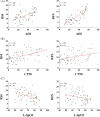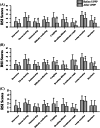Changes in laryngopharyngeal reflux after uvulopalatopharyngoplasty for obstructive sleep apnea: An observational study
- PMID: 35155807
- PMCID: PMC8823242
- DOI: 10.1002/lio2.718
Changes in laryngopharyngeal reflux after uvulopalatopharyngoplasty for obstructive sleep apnea: An observational study
Abstract
Purpose: To estimate laryngopharyngeal reflux (LPR) changes after uvulopalatopharyngoplasty (UPPP) for obstructive sleep apnea (OSA) using the reflux symptom index (RSI) and reflux finding score (RFS) questionnaires.
Methods: A total of 91 participants were recruited and divided into three groups: control (n = 27), OSA mild to moderate (n = 29), and OSA severe (n = 35) groups according to polysomnography. All participants completed the preoperative RSI, and underwent blinded evaluation on videolaryngoscopy using the RFS questionnaire. Thirty-four OSA patients who underwent UPPP surgery completed postoperative polysomnography and questionnaires again after a 6-month follow-up.
Results: The RSI score and RFS were higher in patients with OSA than in those without OSA. Patients with severe OSA also had a higher RSI score and RFS than those with mild to moderate OSA. Apnea and hypopnea index degree and percentage of recording time for <90% oxygen saturation showed positive correlation with LPR symptoms. But the lowest blood oxygen saturation during the recording time was negatively correlated with LPR symptoms. The mean RSI score and RFS before UPPP surgery were 15.88 ± 4.85 and 13.18 ± 4.80, after surgery decreasing to 9.53 ± 4.16 and 8.65 ± 4.87, respectively (P <.05). In 25 patients where surgery was successful, RSI scores, RFSs and individual RSI variables decreased after surgery.
Conclusions: LPR symptoms are common among OSA patients, and the coexistence of OSA and LPR cannot be ignored. Successful UPPP surgery potentially reduces LPR symptoms and improves laryngoscopic signs by alleviating sleep respiratory disorders. Level of Evidence: 3.
Keywords: laryngopharyngeal reflux; obstructive sleep apnea; reflux finding score; reflux symptom index.
© 2021 The Authors. Laryngoscope Investigative Otolaryngology published by Wiley Periodicals LLC on behalf of The Triological Society.
Conflict of interest statement
The authors declared that there is no other funding, financial relationships, or conflicts of interest to disclose.
Figures



Similar articles
-
Laryngopharyngeal Reflux in Obstructive Sleep Apnea-Hypopnea Syndrome: An Updated Meta-Analysis.Nat Sci Sleep. 2022 Dec 15;14:2189-2201. doi: 10.2147/NSS.S390272. eCollection 2022. Nat Sci Sleep. 2022. PMID: 36545474 Free PMC article. Review.
-
Association between laryngopharyngeal reflux and obstructive sleep apnea in adults.PeerJ. 2022 Apr 25;10:e13303. doi: 10.7717/peerj.13303. eCollection 2022. PeerJ. 2022. PMID: 35497179 Free PMC article.
-
Therapeutic Effect of Multilevel Surgery on Laryngopharyngeal Reflux in Obstructive Sleep Apnea Patients: Impact on the Reflux Symptom Index and Reflux Finding Score.Clin Exp Otorhinolaryngol. 2022 Nov;15(4):346-353. doi: 10.21053/ceo.2022.00563. Epub 2022 Jul 15. Clin Exp Otorhinolaryngol. 2022. PMID: 35835547 Free PMC article.
-
The effect of obstructive sleep apnea surgery on laryngopharyngeal reflux with obstructive sleep apnea.Acta Otolaryngol. 2020 Aug;140(8):697-701. doi: 10.1080/00016489.2020.1755448. Epub 2020 Apr 27. Acta Otolaryngol. 2020. PMID: 32340527
-
Laryngopharyngeal reflux in obstructive sleep apnoea patients: Literature review and meta-analysis.Am J Otolaryngol. 2018 Nov-Dec;39(6):776-780. doi: 10.1016/j.amjoto.2018.09.006. Epub 2018 Sep 12. Am J Otolaryngol. 2018. PMID: 30224217 Review.
Cited by
-
Laryngopharyngeal Reflux in Obstructive Sleep Apnea-Hypopnea Syndrome: An Updated Meta-Analysis.Nat Sci Sleep. 2022 Dec 15;14:2189-2201. doi: 10.2147/NSS.S390272. eCollection 2022. Nat Sci Sleep. 2022. PMID: 36545474 Free PMC article. Review.
References
-
- Young T, Palta M, Dempsey J, Skatrud J, Badr S. The occurrence of sleep‐disordered breathing among middle‐aged adults. N Engl J Med. 1993;328(17):1230‐1235. - PubMed
-
- Kapur VK. Obstructive sleep apnea: diagnosis, epidemiology, and economics. Respir Care. 2010;55(9):1155‐1167. - PubMed
-
- Bikov A, Hull JH, Kunos L. Exhaled breath analysis, a simple tool to study the pathophysiology of obstructive sleep apnoea. Sleep Med Rev. 2016;27:1‐8. - PubMed
-
- Tawk M, Goodrich S, Kinasewitz G, Orr W. The effect of 1 week of continuous positive airway pressure treatment in obstructive sleep apnea patients with concomitant gastroesophageal reflux. Chest. 2006;130(4):1003‐1008. - PubMed
-
- Fournier MR, Kerr PD, Shoenut JP, Yaffe CS. Effect of nasal continuous positive airway pressure on esophageal function. J Otolaryngol. 1999;28(3):142‐144. - PubMed
LinkOut - more resources
Full Text Sources
